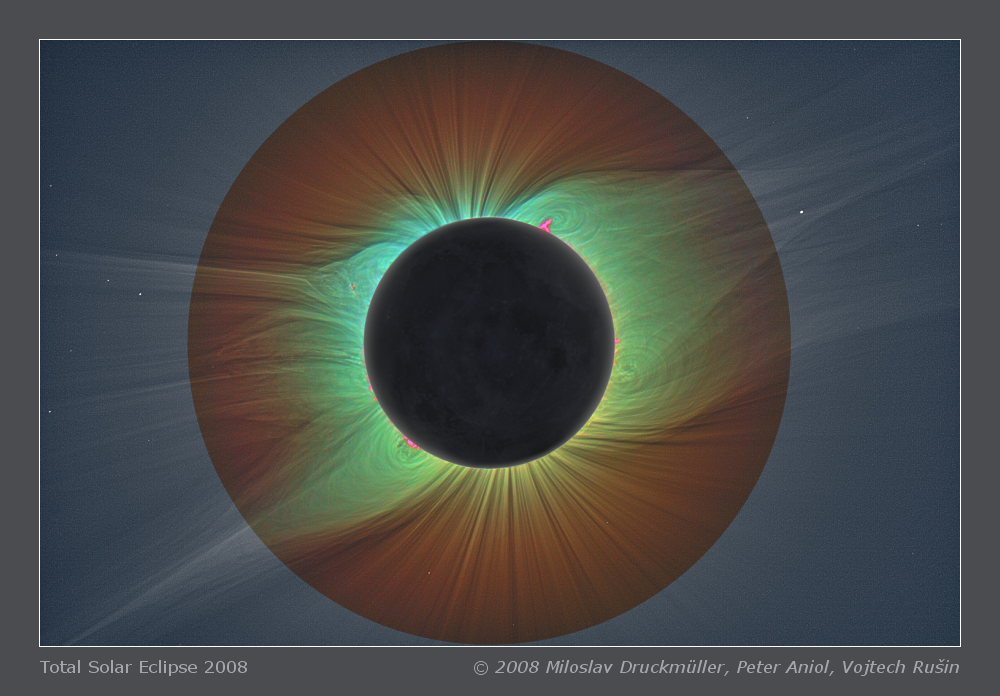
True colors of solar corona
What is the color of the solar corona? The majority of people perceive the corona during eclipse as white
or slightly greenish-white. However bluish-white, yellowish-white or reddish-white are often reported
too. The problem is in the color perception by human vision which is dependent on the definition
(calibration) of white color. The less the color differs from white i.e. the less is the color
saturated the more critical is the precision of white color calibration. If we use the natural
definition that photospheric light is white, we may distinguish very small but still well detectable
differences of solar corona coloring. Suppressing the white color component i.e. increasing of color
saturation enables detailed study of the color variation throughout the inner corona.
It was not easy to create the image which is presented on this page. 23 images taken during the eclipse
and over two hundred calibration images (dark frames, flat-fields) were necessary to use in order
to obtain precise color definition, moreover, blue color of the sky caused by Rayleigh scattering
was necessary to remove. Finally the color saturation was increased 50×.
From the physical point of view, the image processing suppressed the white color of photospheric
light scattered by electrons (K-corona). The green color dominating the innermost part of the corona
is without any doubt caused by Fe XIV "Coronium"
(530.3 nm) emission and this
color visualizes areas of hot plasma with temperature of about 1.8 MK. There is a perfect
correspondence with
images taken by our expedition using narrow band filters.
Obvious is the interpretation of the reddish-pink color of the prominences caused by prominent
H-alpha radiation. More complicated is the interpretation of the red color which dominates the
outermost part of the processed area. The red shift of the color in the radial direction is probably
caused by the increasing significance of the F-corona formed by dust particles scattering the
photospheric light. The F-corona, regarded as the continuation of the zodiacal light
near the Sun, is of reddish color. The
Fe X
radiation (637.4 nm) is of red color
too and it is probably responsible for the red-purple coloring which is slightly visible on the
right side and on the left side of the processed image part.
The influence of relatively low altitude of the Sun above the horizon (22°) is worth mentioning too.
If we orient the image as it was observed in the sky, it is visible that
in the lower part the blue part of the spectrum is slightly suppressed. It is caused by the longer path
of the light though Earth atmosphere which filters the shorter wavelengths more intensely than the
longer ones.
Finally, the answer to the question "What is the color of solar corona?" is that the
innermost part of the corona is nearly white with small shift to green especially in active
regions which is due to Fe XIV radiation. The color shifts to slightly reddish-white with increasing
distance but yellowish-white areas also exist as the yellow color is the mixture of green and red color.
Finally the corona disappears in the blue color of the sky in its outer part. In the universe out
of the Earth's atmosphere, the corona would continuously extend as zodiacal light which is of a
slightly reddish color.
Click on the image or on the following reference to display the
higher resolution image version (2.3 MB, PNG format).
|
| Image | Tse2008_1000_hic1.png |
| Date | 01. 08. 2008 |
| Time | 2nd contact 11:03:35 UT, 3rd contact 11:05:39 UT
Total eclipse duration 2 m 4 s |
| Place | Mongolia, Bor Udzuur |
| Coordinate | 45° 43.251' N, 92° 06.837' E, 1223 m altitude |
| Conditions | Excellent - clear sky, altitude of the Sun above the horizon 22° |
| Optics | Rubinar 10/1000mm |
| Camera | Canon EOS 5D digital camera (ISO 100 and 200) |
| Exposure | 1/60 s - 8 s at ISO 100 and 8 s at ISO 200 |
| Processing | Composition of 23 images. Eclipse images calibrated by means of dark frames and flat-fields, aligned by means of phase correlation, composed and colorimetricalally processed by means of LDIC 5.0 software, processed using Corona 4.1 in order to visualize coronal structures. Final processing was done using ACC 6.1 software.
Image processing by Miloslav Druckmüller |
| Software | Astro D3F 2.0, PhaseCorr 6.0, LDIC 5.0, Corona 4.1, Sofo ACC 6.1 |
| Orientation | Image must be rotated 12.1° clockwise to achieve standard orientation i. e. North up. |
| Copyright | © 2008 Miloslav Druckmüller, Peter Aniol, Vojtech Rušin |

|
Miloslav Druckmüller
Institute of Mathematics, Faculty of Mechanical Engineering
Brno University of Technology, Czech Republic
druckmuller@fme.vutbr.cz
|
Page last update: 27.11.2019
|
|

